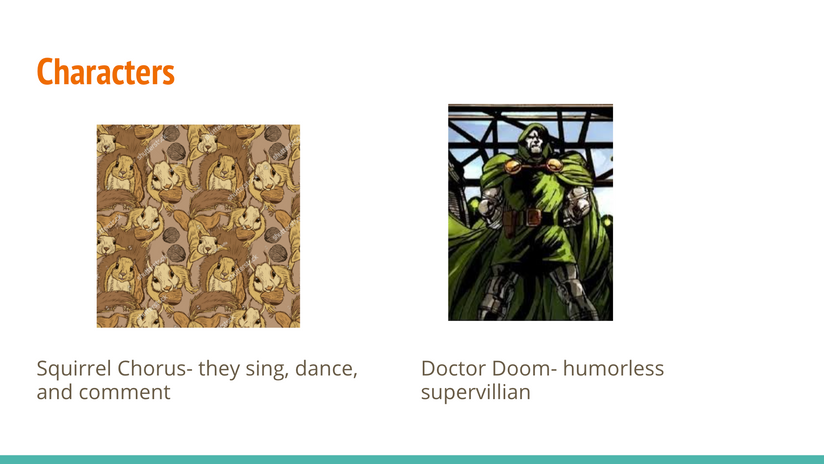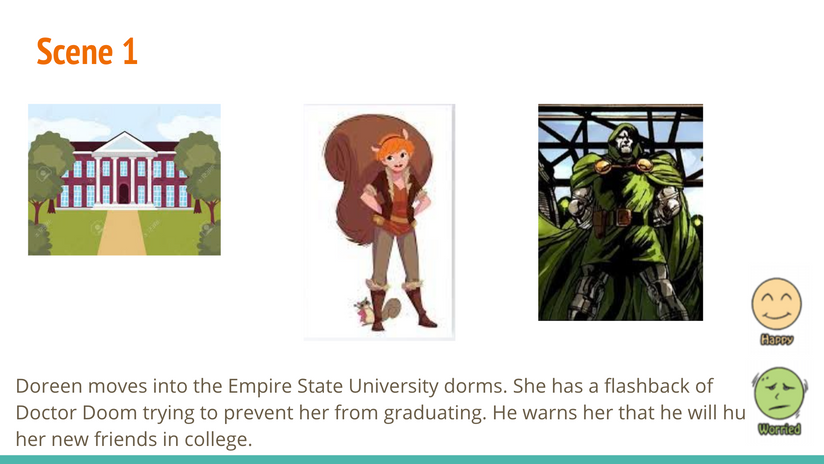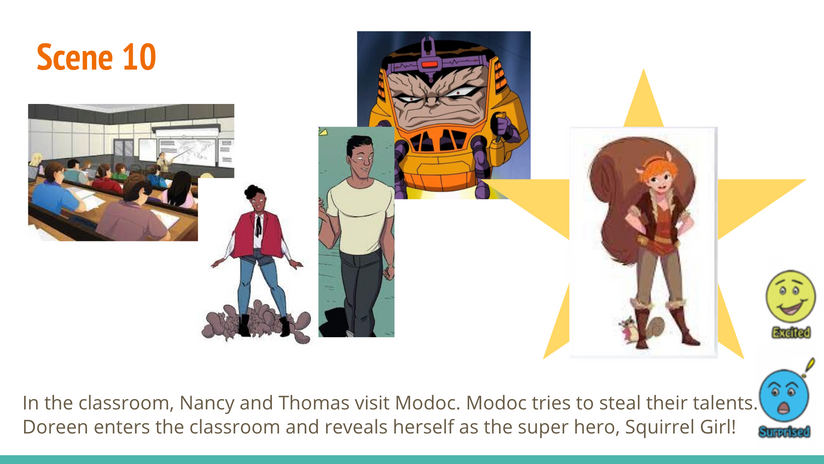Glossary
bonding creating a close relationship.
bonanza a sudden increase in luck, or good fortune.
carb short for carbohydrate: a kind of food made up of starch, sugar, and cellulose on a chemical level. Wheat and corn products, like popcorn, are examples of carbs.
confidential secret.
clone an identical copy of another living thing.
diverse showing a great deal of variety in backgrounds and traits.
dynamic full of energy and new ideas.
dyslexia a learning disorder that involves difficulty with reading or
interpreting words, letters, or other symbols.
engaged deeply involved, paying attention.
Et tu, Brute? an exclamation of surprise! Translates to “And you, Brutus?”.
Comes from William Shakespeare’s play, Julius Caesar, where Caesar can’t believe his close friend, Brute, has betrayed him.
flashback a scene that is set back in time, before the events of the present Greek chorus; A group of actors or characters who comment on the events of a play with song, dance, and recitation. Comes from ancient Greek theatre.
innovative advanced and original, introducing new ideas.
pharmaceutical relating to medicine or the use and sale of prescription
drugs.
pompous irritatingly grand, or self-important.
propelled driven or pushed in a certain direction.
rabies a contagious disease— transmitted through saliva from mammals such as raccoons, dogs, or chipmunks— that causes fevers, muscle spasms, and frothing at the mouth.
rodent a small, gnawing mammal such as a mouse, squirrel, or beaver,
usually characterized by buck teeth.
sabbatical paid leave, usually given to teachers, for study or travel.
vulnerable being emotionally honest about thoughts and feelings— even
ones that are private or hard to talk about.
Yes, and… a guideline for theatrical improvisation that encourages
participants to add on to what has come before, rather than
ignoring it and starting from scratch.
With plays such as Jane of the Jungle, Frida Libre, Destiny of
Desire, and many, many others, Karen Zacarias is one of the most
produced playwrights in the United States. Born in 1986 in Mexico,
many of her plays revolve around the Hispanic and LatinX experience.
Because of her passion for the lives and cultures of the LatinX community, she founded the Latinx Theatre Commons at the HowlRound Theatre in Boston, Massachusetts. From their own words,
“The Latinx Theatre Commons is a national movement that uses a commons-based approach to transform the narrative of the American theatre, to amplify the visibility of Latinx performance making, and to champion equity through advocacy, art making, convening, and scholarship. The LTC is a flagship program of HowlRound.”
Another one of Karen Zacarias’ passions are the voices of young artists. Zacarias has written over nine plays for young audiences, including Squirrel Girl. One of which is titled Chasing George Washington. Commissioned by the White House, the play follows the characters Dee, José, and Annie on a field trip to a museum at the White House. When they accidentally knock George Washington out of his portrait, their school trip turns into an educational adventure about the families who have lived in that historic house. After the success of her play, it was turned into a book by Scholastic that included a foreword written by Michelle Obama.
With playwrights such as Karen Zacarias, young people are able to see themselves onstage. In 2019 the percentage of theatre for young audiences playwrights who identify as People of Color was at 20%, over double of the 9% in 2009. The increase in POC playwrights writing means that the stories of POC on the stage is also increasing. The theatre world is one that has been dominated by white men for a very long time. It is exciting to see a shift in that continuous cycle in the past few years. People of all different races and genders can see themselves represented accurately. And who doesn’t want to see stories like theirs onstage?
About the Playwright
Karen Zacarias

Female Superhero Timeline


Articles
How Squirrel Girl Came to Be
Ask your teacher: what was the culture of comic books like when they were growing up? Who bought them? What were they about? Did they read comics at all in middle or high school, and if they did, did they tell anyone?
More than likely, your teacher will remember comic books being treated very differently than they are today. Marvel Comics wasn’t always the pop culture titan it is in the year 2021. There were no Avengers movies. No spinoff TV shows. No quizzes that would tell you, once and for all, which superpower you were meant to have. In fact, it used to be pretty nerdy, even abnormal to take an interest in comics. Certainly in the 1960s, when the first edition of Spider-Man came out.
Comic book readers were thought of as antisocial (for preferring to read about people rather than talk with them), and geeky (for daydreaming about strong, unrealistic heroes). They were also usually thought to be teenage boys.
For a long time, Marvel Comics only told stories they thought young men could relate to. Spider-Man, Iron Man, The Hulk, and Thor were all written with this audience in mind. They dealt with villains, bullies, and love interests like anyone else, but more often than not, with a male perspective.
Now, over 60 years later, Marvel has expanded its cast of characters to try and include more heroes of diverse backgrounds. There are writers working with the company today whose goal is to represent young people in a way they failed to see in their childhood— and to create complex, interesting stories behind the scenes of their superpowered lives.
Karen Zacarías, the playwright behind Squirrel Girl Goes To College, wanted to make sure the young heroine’s internal conflicts took center stage. “In this play, she’s a little vulnerable from changing schools. She’s trying to figure out the right thing and has great intentions, but she makes mistakes. I wanted to touch on the fact that she’s sometimes a little lonely, and that’s something about her that we don’t get to see as often.”
Though Zacarías isn’t the first author tackling theatrical adaptations of comic book characters, she’s the only one to bring Doreen Green, or Squirrel Girl, to the stage. Wait another 60 years, though, and that may have changed, too.

The Unbeatable Squirrel Girl
In the year 1941, DC Comics released the first well-known female superhero with Wonder Woman. Back then there was no Marvel Comics, let alone a Squirrel Girl, but Wonder Woman proved to be very popular, since she remains a major hero today. She was strong, independent, and fought for freedom. And yet, she remained one of few. Despite the fact that young girls made up a sizable portion of the comic book audience, Wonder Woman remained one of the only female superheroes for years. In fact, within superhero comics, most female characters were sidekicks, or girlfriends, but rarely the heroes.
It wasn’t until the creation of Marvel Comics in 1961 that the public began to see more female superheroes. But even then, female superheroes tended to be supporting characters (such as Susan Storm Richards or Invisiblegirl in the Fantastic Four) or were spin-offs of male superheroes (Such as Batgirl or Supergirl). Still, Marvel developed a reputation for trying to create heroes that were relatable and tackled real issues, leading to the creation of popular characters like Peter Parker, AKA Spider-Man. He was a big hit because he was a normal teenager as well as a superhero, something many people could relate to. We see this repeated in the hero Squirrel Girl.
As Marvel grew in popularity, so did their fictional universe. Throughout the 70s and 80s they, as well as other comic book companies, began to make darker, more mature comics to appeal to adults. So while we were seeing more women, like Ms. Marvel or Storm from the X-Men, the plotlines were becoming more and more serious.
With the creation of Squirrel Girl, Marvel introduced a character that was light-hearted and fun, while also being powerful. She was smart and strong, but also compassionate and goofy, a call back to the more childlike comics of the past. However, while past comics rarely featured women, The Unbeatable Squirrel Girl puts Doreen Green front and center. She’s the hero of her story, and she loves being one. Her comics are fun for people of all ages and she’s a fantastic role model for young girls, as she teaches them to be themselves, and kick butt!
Themes of the play:
-
Girl power
-
Making friends
-
Self-tips for becoming the best student you can be
-
Accepting yourself for who you are
Which one of these themes excites you the most?
Everything You Need To Know About Squirrels
“Why squirrels?” and “Why is there a superhero with squirrel powers?” you might ask. Well, squirrels are extraordinary little creatures! Despite their common appearance in every neighborhood in the United States, squirrels hold much power. Now lets see how much you think you know about squirrels!
T or F : When jumping, or falling, squirrels can use their tail both for balance and as a parachute.
T or F : Squirrels have padded feet.
T or F : Squirrels can run up to 20 mph.
T or F : Squirrels can learn skills from other animals and humans.
T or F : Squirrels can leap 10 times their body length.
Squirrels have large, fluffy tails and padded feet that can act as a cushion while falling. Because of their tails and feet, they can fall from over 90 feet without hurting themselves. Their padded feet also help when they are running away from prey. The pads act just like shoes do when we run. They help the squirrels to not get blisters and to run on uneven surfaces, like trees. While running up trees, their ankles can turn 18 degrees so they can face any direction while climbing. Because squirrels tend to live in trees, their feet, ankles, and tails can help them to escape other far more dangerous animals that also live there.
But these animals do not just pose a threat to the lives of the squirrels, but they are also beneficial. Squirrels have the ability to learn skills from watching other animals and humans. By seeing a woodpecker use their beak to break the shell of a nut, squirrels can copy that movement by pounding the nut against a sharp branch or rock. Their ability to learn quickly have made squirrels very useful to humans. In the 2005 Willy Wonka and the Chocolate Factory, all the squirrels in the nut check point are not computer generated animations. They are actually real life squirrels! They were trained by professional Hollywood animal trainers to perform on screen.
HOVER TO SEE RESULTS
If you answered True for all of them, you would be right!
Fun Fact: Squirrels are spies!
In 2007, Iran claimed that 14 squirrels found near their borders were actually spies.
Lean, Mean Doreen Green
Click the video below to learn more about Squirrel Girl's other persona, Doreen Green!
Create Your Own Marvel Superhero
Social Story
Learn about what to expect when watching Squirrel Girl!
Activities
Facing Your Fears
Goal: By finding ways to face your own fears, you are then able to consider the steps the characters in each play take to facing their fears.
Materials:
-
Blank piece of paper
Instructions:
-
Take about two minutes of quiet reflection time to consider the following question, “what is one of your biggest fears?” Then, write down the fear on a piece of paper.
-
As a class, create a Fear Map using the answers everyone gave to the previous question. The fears given in the answers will be grouped into categories of similar fears. For example, if the fear one person listed is spiders and the fear another person listed is snakes, these two fears can be grouped together in a category called “nature.”
-
Once the categories of fears are created, sit with the students whose fears are in the same category as you. In your small groups, fill out the Facing Your Fears Form individually, but discuss each section as a group. See the Facing Your Fears Form below the activity instructions.
-
Watch the following video to learn about one of the tactics used to face fears in Tall Enough: Deep breathing. Follow along with the video as a class and begin to think about how actors use their breath to perform for long periods of time.
Learning styles: Spatial, aural, and visual
What tactics does Squirrel Girl use to beat the villains Mocdoc and Doctor Doom? What holds her back from facing the villains?
Showing Your True Self
Goal: By observing what makes you unique and where your choices come from, you will be better able to understand why it is so difficult for the characters in each play to show their true selves.
Materials:
-
Coloring materials: Colored pencils, markers, etc.
Instructions:
-
Look at your appearance and consider what clothes you are wearing, how you style your hair, how you carry yourself, how you sit in a chair, how you speak, etc.
-
Pair up into groups of two with someone you do not know very well and do the same exercise, but with their partner. Consider what clothes they are wearing, how they style their hair, how they carry themselves, how they sit in a chair, how they speak, etc.
-
Play a mirror game with your partner. Take turns copying each other’s movements and discuss the differences in what movements you chose.
-
Have a discussion about why you wear the clothes you wear, why you style your hair in a certain way, and how these aspects indicate how you present yourself to the world. Do you incorporate your culture? Do you incorporate the latest trends? Do you go against the grain on purpose?
-
Discuss as a class what you would look like if there were no rules to how you could present themselves and how you can begin to incorporate these dreams into your own life. For example, if you love wearing bright colors, how can you start wearing more bright colors? Can you make a brightly-colored wristband to wear? Draw a sample appearance outline of what you would want to wear, how you would style your hair, etc. using the True Self Drawing.
-
Set a concrete goal for how to better align with your true self based on the class discussion.
Learning styles: Spatial, aural, and visual
What are the influences around Squirrel Girl that make her hesitant to share her true self?
Be Your Own Superhero
Goal: By considering what makes you a superhero, you will be able to use your creativity to discover the true power of superheroes: Helping people.
Materials:
-
Construction paper
-
Coloring materials: Colored pencils, markers, etc.
-
Tape
Instructions:
-
Have a group discussion as a class about what you consider a superhero to be. What does a superhero do to help their community? What attributes does a superhero have (kindness, honesty, compassion, etc.)?
-
Design Be Your Own Superhero posters. Each poster answers the prompt “I am a superhero because I…” This activity can be in a group or individual, depending on the needs of the class. For a visual example, see below activity instructions. Some examples:
-
I am a superhero because I help my mom do the dishes after dinner.
-
I am a superhero because I say kind things about my friends.
-
I am a superhero because I say “please” and “thank you.”
-

Learning styles: Aural and visual
What does your superhero identity say about who you are? What does Squirrel Girl’s superhero identity say about who she is?
CONGRATULATIONS!























